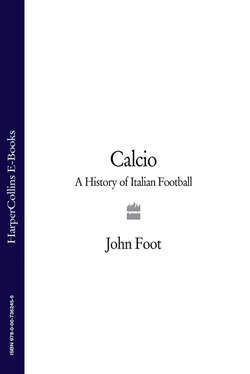Читать книгу Calcio: A History of Italian Football - John Foot - Страница 23
From Lions to bankruptcy. The rise and fall of Pro Vercelli
ОглавлениеVercelli is (and was) a sleepy, rice-growing town on the Piedmont plains, between Turin and Milan. Yet, between 1908 and 1913, and then again from 1921–1923, the town’s football team – Pro Vercelli – was more or less unbeatable. Pro Vercelli lost just one championship in the five years between 1908 and 1913 – and even that was in extremely controversial circumstances. The club’s rapid rise has been attributed largely to their modern training methods and tactics, and to the extraordinary fitness of their players.
This small-town team, with players who were not only all Italians but almost entirely from Vercelli itself, demonstrated that early football success was not so much about talent, but also about determination, preparation and teamwork. One of Vercelli’s most celebrated players – the midfielder Guido Ara – allegedly coined the Italian cliché ‘football is not a game for little girls’. Vercelli was the first modern Italian club, on and off the pitch, and the lessons of its victories were to become part of the DNA of calcio from that moment on. Corners and free-kicks were practised in training and the team controlled possession instead of simply booting the ball upfield. They were also very young – the average age of the 1908 squad was just twenty. In Genoa’s 1906 team, Spensley was nearly 40 and Pasteur, another key early player, was 30. Pro Vercelli often dominated the last fifteen minutes of games, relying on their exceptional strength. The club was perhaps the first to have a serious youth policy which paid off handsomely. A series of legendary players came through the ranks. Giuseppe Milano was their formidable captain before the war and his brother Felice won five championships at Vercelli, before dying in the trenches in 1915, at the age of 24.
Pro Vercelli played in white shirts with starched collars and cuffs and were one of the first teams to inspire loyalty and almost religious fervour among their fans. Pro Vercelli were also given a rhetorical nickname – The Lions – which tied in neatly with the nationalist rhetoric emerging in Italy at that time. As an all-Italian, provincial and local team, Pro Vercelli represented national pride against the foreigner-dominated clubs from the cosmopolitan cities of Milan and Turin. It was no accident that in the first national team game in 1910 Italy’s shirts were white, in homage to Pro Vercelli.29 So dominant was the Vercelli squad in this period that they provided nine of the eleven players who played for Italy against Belgium in May 1913.30 A staggering eight of these nine players were from the little town of Vercelli itself.
In 1910, Inter and Pro Vercelli finished level on points at the end of the season. The title playoff was to be played in Vercelli because of their superior goal difference. However, on the date chosen by the federation a number of Pro Vercelli players were committed to a military tournament. The club asked for the date to be put back but the federation (and Inter) refused. In protest, Vercelli played their fourth team (made up of 10–15-year-olds). Not surprisingly, Inter won easily, 10–3. Pro Vercelli were furious, and were banned until the end of the year for their impudence. An amnesty relaxed the ban in October and Pro Vercelli swept to the title in 1911, 1912 and 1913. The team was famous enough to gain a prestigious invitation to tour South America in the period before the war. After winning two more championships in the 1920s Pro Vercelli began a long decline. As a poor, small-town club, they were unable to hold on to their star players in an increasingly professional game.31
In decline, however, Pro Vercelli’s youth team managed to produce a striker who turned out to be perhaps the most extraordinary player of his generation. Born in a small town near Pavia in 1913, Silvio Piola moved to Vercelli as a little boy and went on to a career that no other player has come close to matching. After making his debut in 1930 Piola played five seasons for Pro Vercelli, scoring 51 goals and he remained close to his old squad even after Lazio signed him for a record fee in 1934. Pro Vercelli’s president had once stated ‘we will never sell Piola, not even for all the gold in the world. Once we sell him, the decline of Pro Vercelli will begin.’ He was right. His side finished bottom of Serie A with only fifteen points in that year and, once relegated, they were never to return to add to their seven championship titles. Piola went on to greatness and in 21 war-interrupted seasons stretching from 1930 to 1954 he scored 290 goals in 566 games in Serie A.
Pro Vercelli languished in the lower levels of the semi-professional game for a time, before rising slowly up to Serie C again by the end of the 1990s. However, by 2003, like so many other clubs, they were in financial crisis. In December of that year, bankruptcy proceedings began after the club failed to pay player wages. The company which owned the club – whose name was Spare Time – had debts of over £600,000. Pro Vercelli’s players were forced to have a whip round to pay for their transport to an away match. A Committee to Save Pro was set up and began looking desperately for a buyer. Today, Pro Vercelli struggle on in one of Italy’s third divisions, backed by a small group of loyal fans.
